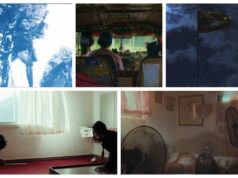La Alegre and the Waray zarzuela Lunop Han Dughan
By Victor N. Sugbo
Theater Review
Lunop Han Dughan
Written by Samlito Abueva
Directed by Joycie Dorado Alegre
UP Visayas, Tacloban City
Nov. 7 and 9
LUNOP HAN DUGHAN, shown in Tacloban City on Nov. 7 and 9, brought a new whiff of dramatic energy to the traditional Waray zarzuela and community theater after two decades of moribund theater activity in Tacloban. Previous presentations of Waray zarzuelas were mostly nostalgic revivals, notably the plays of Iluminado Lucente whose works still lend well to staging. Held for the 6th Commemoration of the Supertyphoon Yolanda Disaster, Lunop was not the usual zarzuela. While it carried the trappings of the form — music, songs, dances, and dialogue — Lunop underwent a kind of reinvention. Surreal, metonymic and folksy, its new configuration seemed designed to test the waters of social acceptance with its new audience.
A complex narrative consisting of local myth, realistic events, minimal realia, old folk and new pop songs, surrealism, and the return of an old love, Lunop unpacks surprises and a certain realization. The first surprise was that the original music played during the deluge scene and the Magna Mater’s lamentation scene were compositions of National Artist for Music and UP Professor Emeritus Ramon Santos, who also conducted the performance of his original compositions, played by the rondalla musicians of the Leyte Kalipayan Dance Company and Leyte National High School Special Program for the Arts.
The second surprise was the appearance of UP soprano and voice professor Alegria Ferrer as Magna Mater (earth mother) whose theatrical presence and vocal prowess, essaying the sung prophecies and lamentation, electrified the stage.
Despite their exposure to vibrant K-pop, J-pop, variety shows, and cinema, the young audience were no different from their great-grandparents who watched an Iluminado Lucente zarzuela in Plaza Rizal sometime in the late 1940s and ’50s. Like past habitués of Lucente zarzuelas, they participated in Lunop by applauding every time an actor or set of actors sang. In their seats, they would occasionally hum the song along with the actors. They would also burst into waves of muffled giggles and guffaws whenever the star-crossed lovers, Urbano and Maribel, met looking at each other intensely, singing their plaintive sad songs.
The revival of folksongs that may have been forgotten by Tacloban lightened sad and heavy moments in Lunop. It made the older audience nostalgic. It also provided the younger audience a taste of melodic Waray compositions written by the almost forgotten Pablo Rebadulla of Calbayog and A. Jaro of Tacloban, along with the new bouncy tunes written and composed by Samlito Abueva.
Lunop is a directorial oeuvre of Joycie Dorado Alegre. For her, theater performance is not an inert object. She views it as a fluid fabric. For this reason, the sensorial texture of the play undergoes regular assessment, modification, reinvention or revision. Theater directing, in this case, becomes an active orchestration of elements that transmutes from acting to blocking, from singing to dancing, a jagged search for the appropriate theater syntax. As such, acting undergoes frequent modification. Only the text is left untouched. Depending on exigencies, however, it too gets altered. In this regard, the play’s text is never final, and is in transit.
As though these are not enough, Alegre treats her actors like clay whose acting and singing she must keep shaping and reshaping. In this way, each stage presentation becomes a perilous auditory and visual adventure, as changes introduced into each performance of the play could break into a vulgarity. This approach to theater resonates from her past theater work, where she envisioned and still envisions the play’s performance as an unremitting search for the figurative theater morpheme that would bring out what she thinks the audience should feel and believe in the end.
In Lunop, Alegre boldly juxtaposes the hyperbolic time of Dang and Mulay (in the Mount Danglay myth) with the realistic narrative time of Urbano and Maribel. In both stories, Dang and Mulay and Urbano and Maribel meet tragic deaths; Dang and Mulay, in the deadly embrace of a giant crab that strangles them; Urbano and Maribel, in the whirling flood waters of a super typhoon. This juxtaposition implicitly paints Urbano and Maribel as likely incarnations whose ill-fated lives were already written in the stars.
The story of Lunop is a simple narrative about a married couple, Maribel and Turing, who by force of circumstances, are compelled to marry. Turing is a dynamite fisher, a womanizer, and a drinking sot. Maribel marries him because her father owes a large debt to Turing’s father. The union is blessed with three children but it is not a happy marriage. The arrival of Urbano in the coastal village where Turing and Maribel live complicates matter. A mariner on vacation, Urbano gets to talk to Maribel during a fiesta celebration in Turing’s house. In this brief time they have, Urbano and Maribel profess love for each other, but they both know their love can never be fulfilled. Turing catches Urbano and Maribel talking intently and commands Urbano to leave his wife.
The occurrence of a violent storm turns the coastal village of Turing and Maribel in disarray. This is further aggravated by the rising flood waters driving people to higher grounds. Caught in the flood waters, Urbano finds Maribel and her children on an elevated area, but even this is claimed by the flood. Maribel slips into the rising water and Urbano tries to save her, and in their flurry to save each other they are seen by Turing who is also struggling to save himself. Unaware of impending danger, Urbano and Maribel are overrun by an unmanned cargo ship which the violent storm winds and the surging swollen sea drive in the direction of Turing’s coastal community. Now alone, Turing redeems himself from his guilt by assuring his children of his love and care.
How Alegre unravels the simple narrative of Urbano and Maribel and the ill fate of Turing is in itself interesting. With actors who undertook nights and nights of grueling acting, she mounts the play on a layered circular stage. Designed by UP Architect Jose Danilo Silvestre, it became the tight but fragile cosmos where nature defined human fate and where lives rose and fell. With the minimal use of realia, Lunop opened for Alegre the opportunity to play with metonyms. The placement of two seats in a spot on the stage, for instance, turned the space into a metonym for a living room. Interestingly, the predominantly red mats of Basey, Samar in the hands of strange-looking sea harpies (dancers) became a wall in one scene, and frightening sea waves in another scene — dance sequences co-designed with choreographer Eulogio Plameran. The lighting of candles at the penultimate scene stood for the tapos, a ritual marking the end of prayers for the dead. Moreover, the reappearance of Dang and Mulay towards the end of the play animated the emotional low point of the audience in that Urbano and Maribel appeared like resurrected souls in the afterlife. In our cosmos, there are really no finalities. There are just passages. The use of metonymy and myth, the presence of Magna Mater and the gossamer Mount Danglay backdrop created by painter Archie Zabala, provided a surreal feel to the play’s performance.
The realistic plot and dialogue and the surreal atmosphere inherent in the stage presentation comprised a paradox that Alegre had to contend with. She, however, transcended these by putting actors under intensive training so they could enact their roles with a finely tuned devotion to create believable stage selves outside of their own. Notable here was the acting of Pierre Dan Ampo, who literally absorbed his loud-mouthed and menacing Turing persona. Equally noteworthy were the laudable performances of Urbano (Gabriel Asanza) and Maribel (Lina Fe Simoy) as the ill-fated lovers whose meetings were at times humorous, many times poignant and sad. Turing and Maribel’s children Aliya (Elizabeth Zamora), Makoy (Jay Cris Juyad), and Egay (Melanie Ladica); the comic characters of Sayong, (Danica Ybañez), Tiyong (Mark Joseph Daduya), Doming (Ivan Ray Pontoy), and Dulce (Rosary Jasmine Padilla); the Theater Arts students who acted as strange-looking sea harpies — all turned in credible performances. Despite the brevity of their appearances, they contributed to the successful staging of Lunop as written by Samlito Abueva. Once more Alegre proved her worth as theater director cum auteur. The enthusiastic public reception of her work in Lunop was an attestation.
The presentation of Lunop Han Dughan was made possible by the UP Visayas Tacloban College, the UP Office of the Vice-President for Academic Affairs (Enhanced Creative Work and Research Grant) in partnership with Silhag Cultural Association in the Philippines and the National Commission for Culture and the Arts. The An Waray Party List likewise served as sponsor.
Dr. Victor Sugbo is a multi-awarded poet, professorial lecturer of Literature and Communication in UP Visayas Tacloban College.



